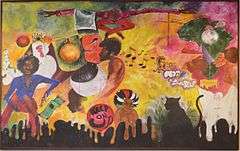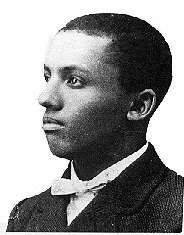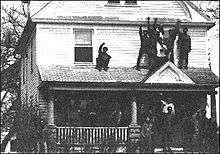Black History Month
| Black History Month | |
|---|---|
 A painting dedicated to the founders of Black History Month, the Black United Students at Kent State University, by Ernie Pryor.[1] | |
| Also called | African-American History Month |
| Observed by | United States, Canada,[2] United Kingdom,[3] Germany,[4] Netherlands[5] |
| Significance | Celebration of African-American history |
| Date | Months of February and October |
| Frequency | Annual |
Black History Month, also known as African-American History Month in the U.S., is an annual observance in Canada, the United Kingdom, the Netherlands and the United States. It began as a way for remembering important people and events in the history of the African diaspora. It is celebrated annually in the United States[6] and Canada[7] in February, as well as in the United Kingdom, the Netherlands and Republic of Ireland[8] [9] in October.[5]
History

Negro History Week (1926)
The precursor to Black History Month was created in 1926 in the United States, when historian Carter G. Woodson and the Association for the Study of Negro Life and History announced the second week of February to be "Negro History Week".[10] This week was chosen because it coincided with the birthday of Abraham Lincoln on February 12 and of Frederick Douglass on February 14, both of which dates black communities had celebrated together since the late 19th century.[10]
From the event's initial phase, primary emphasis was placed on encouraging the coordinated teaching of the history of American blacks in the nation's public schools. The first Negro History Week was met with a lukewarm response, gaining the cooperation of the Departments of Education of the states of North Carolina, Delaware, and West Virginia as well as the city school administrations of Baltimore and Washington, D.C..[11] Despite this far from universal acceptance, the event was regarded by Woodson as "one of the most fortunate steps ever taken by the Association", and plans for a repeat of the event on an annual basis continued apace.[11]
At the time of Negro History Week's launch, Woodson contended that the teaching of black history was essential to ensure the physical and intellectual survival of the race within broader society:
"If a race has no history, it has no worthwhile tradition, it becomes a negligible factor in the thought of the world, and it stands in danger of being exterminated. The American Indian left no continuous record. He did not appreciate the value of tradition; and where is he today? The Hebrew keenly appreciated the value of tradition, as is attested by the Bible itself. In spite of worldwide persecution, therefore, he is a great factor in our civilization."[12]
By 1929, The Journal of Negro History was able to note that with only two exceptions, officials with the State Departments of Educations of "every state with considerable Negro population" had made the event known to that state's teachers and distributed official literature associated with the event".[13] Churches also played a significant role in the distribution of literature in association with Negro History Week during this initial interval, with the mainstream and black press aiding in the publicity effort.[14]
Negro History Week was met with enthusiastic response; it prompted the creation of black history clubs, an increase in interest among teachers, and interest from progressive whites. Negro History Week grew in popularity throughout the following decades, with mayors across the United States endorsing it as a holiday.[10]
On February 21, 2016, 106-year Washington D.C. resident and school volunteer Virginia McLaurin visited the White House as part of Black History Month. When asked by the president why she was there, McLaurin said, "A black president. A black wife. And I’m here to celebrate black history. That’s what I'm here for."
United States: Black History Month (1970)

Black History Month was first proposed by black educators and the Black United Students at Kent State University in February 1969. The first celebration of Black History Month took place at Kent State one year later, from 2/1/1970 - 2/28/1970.[6]
Six years later, Black History Month was being celebrated all across the country in educational institutions, centers of Black culture and community centers, both great and small, when President Gerald Ford recognized Black History Month, during the celebration of the United States Bicentennial. He urged Americans to "seize the opportunity to honor the too-often neglected accomplishments of black Americans in every area of endeavor throughout our history".[15]
United Kingdom (1987)
Black History Month was first celebrated in the United Kingdom in 1987. It was organised through the leadership of Ghanaian analyst Akyaaba Addai-Sebo, who had served as a coordinator of special projects for the Greater London Council (GLC) and created a collaboration to get it underway.[16] It was first celebrated in London.[17]
Canada (1995)
In 1995, after a motion by politician Jean Augustine, representing the riding of Etobicoke—Lakeshore in Ontario, Canada's House of Commons officially recognized February as Black History Month and honored Black Canadians. In 2008, Senator Donald Oliver moved to have the Senate officially recognize Black History Month, which was unanimously approved.[7]
Republic of Ireland (2014)
In 2014 the Republic of Ireland became only the fourth country in the world to officially celebrate Black History Month. Ireland's Great Hunger Institute notes: “Black History Month Ireland was initiated in Cork in 2010. This location seems particularly appropriate as, in the nineteenth century, the city was a leading center of abolition, and the male and female anti-slavery societies welcomed a number of black abolitionists to lecture there, including Charles Lenox Remond and Frederick Douglass." [18]
Criticism
Black History Month often sparks an annual debate about the continued usefulness and fairness of a designated month dedicated to the history of one race. Criticisms include questions over whether it is appropriate to confine the celebration of Black history to one month, as opposed to integration of Black history into the mainstream education the rest of the year. Another criticism is that contrary to the original inspiration for Black History Month, which was a desire to redress the manner in which American schools failed to represent Black historical figures as anything other than slaves or colonial subjects, Black History Month reduces complex historical figures to overly simplified objects of hero worship. Other critics refer to the celebration as racist.[19]
Black celebrities such as actor and director Morgan Freeman and actress Stacey Dash have criticized Black History Month,[20][21] with Freeman saying, "I don't want a Black history month. Black history is American history." Freeman has argued that there was no White History Month, because white people did not want their history relegated to just one month.[22]
See also
- Other history months
- Asian Pacific American Heritage Month
- Filipino American History Month
- Women's History Month
- LGBT History Month
- Heritage months
- Irish-American Heritage Month
- Jewish American Heritage Month
- Arab American Heritage Month
- National Hispanic Heritage Month
- Puerto Rican Heritage Month
- National Tibetan American Heritage Month
- Native American Indian Heritage Month
- Gay and Lesbian Pride Month
International:
- Black Awareness Day, Brazil
Footnotes
- ↑ Lou Veal, "'Black History Month' begins with opening of culture center", Daily Kent Stater, Volume LV, Number 52, February 3, 1970, Kent State University.
- ↑ Wayde Compton, "Remembering Hogan's Alley, hub of Vancouver's black community", CBC News, February 14, 2016.
- ↑ "Black History Month Introduction; Prime Minister, Theresa May", September 28, 2016.
- ↑ "Black History Month Hamburg".
- 1 2 "Black History Month 2011 - The Association of Students of African Heritage (ASAH) Netherlands", Afro-Europe, February 1, 2011.
- 1 2 Wilson, Milton. "Involvement/2 Years Later: A Report On Programming In The Area Of Black Student Concerns At Kent State University, 1968–1970". Special Collections and Archives: Milton E. Wilson, Jr. papers, 1965–1994. Kent State University. Retrieved September 28, 2012.
- 1 2 "About Black History Month". Citizenship and Immigration Canada. Archived from the original on February 1, 2012. Retrieved February 14, 2012.
- ↑ http://www.thejournal.ie/black-history-month-ireland-1703855-Oct2014/
- ↑ "BHM365". Black History Month 365. Retrieved March 13, 2017.
- 1 2 3 Daryl Michael Scott, "The Origins of Black History Month," Archived February 14, 2013, at the Wayback Machine. Association for the Study of African American Life and History, 2011, www.asalh.org/
- 1 2 C.G. Woodson, "Negro History Week," Journal of Negro History, vol. 11, no. 2 (April 1926), p. 238.
- ↑ Woodson, "Negro History Week", p. 239.
- ↑ "Negro History Week: The Fourth Year", Journal of Negro History, vol. 14, no. 2 (April 1929), p. 109.
- ↑ "Negro History Week: The Fourth Year", p. 110.
- ↑ "President Gerald R. Ford's Message on the Observance of Black History Month". Gerald R. Ford Presidential Library and Museum. University of Texas. Retrieved February 14, 2012.
- ↑ Kubara Zamani, "Akyaaba Addai-Sebo Interview", Every Generation Media, reprinted from New African magazine.
- ↑ "Black History Month FAQ". Black History Month. Archived from the original on February 21, 2012. Retrieved February 14, 2012.
- ↑ Irish Central "How Ireland Is Celebrating Black History Month, 12 Oct 2018
- ↑ Hirsch, Afua (September 30, 2010). "Black History Month has to be more than hero worship". The Guardian. Retrieved February 14, 2012.
- ↑ McCarter, William Matt (2012). "There is a White Sale at Macy's: Reflections on Black History Month". International Journal of Radical Critique. 1 (2). Retrieved January 29, 2013.
- ↑ "Stacey Dash says Morgan Freeman agrees with her views on Black History Month, ask for apology from ‘Twitter haters’", TheGrio, January 27, 2016.
- ↑ "Freeman calls Black History Month 'ridiculous'". MSNBC. December 15, 2005. Retrieved February 14, 2012.
Further reading
- Derrick Bell, "Brown v. Board of Education and the Black History Month Syndrome," Harvard Blackletter Law Journal, vol. 1, no. 1 (1984), p. 13.
- C. G. Woodson, "Negro History Week," Journal of Negro History, vol. 11, no. 2 (April 1926), pp. 238–242. In JSTOR.
External links
| Wikimedia Commons has media related to Black History Month. |